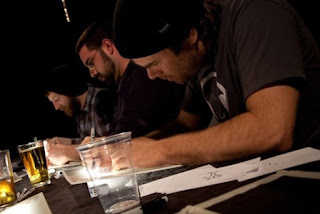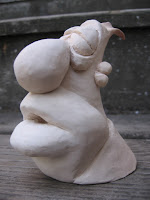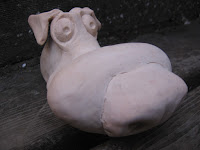Animated Archaeologist
Independent Animator, Mike A. Smith lives in the Pacific Northwest where he works as an Archaeologist and makes animated films in his free time...
I was wondering if you could let us know how you first discovered the process of animation?
 When
I was eight or nine years old, I was in a stop-motion class for kids
for a few Saturdays. A friend and I made some monsters out of plasticene
and shot outside on 8mm film. We didn't know how to have a real story
or fight choreography, so this lumpy hero would just waddle up to the
monsters and chop them into bits with a toothpick sword. We borrowed a
Super 8 camera and made another of those in my backyard. I kept
borrowing and re-borrowing that camera in later years, messing around
with some hand-drawn animation, cutouts, and more clay. Those little
Super 8 experiments were enough to hook me into the process. Even when
it's crude kid stuff, there's a Dr. Frankenstein-like rush when see your
own animation first come to life.
When
I was eight or nine years old, I was in a stop-motion class for kids
for a few Saturdays. A friend and I made some monsters out of plasticene
and shot outside on 8mm film. We didn't know how to have a real story
or fight choreography, so this lumpy hero would just waddle up to the
monsters and chop them into bits with a toothpick sword. We borrowed a
Super 8 camera and made another of those in my backyard. I kept
borrowing and re-borrowing that camera in later years, messing around
with some hand-drawn animation, cutouts, and more clay. Those little
Super 8 experiments were enough to hook me into the process. Even when
it's crude kid stuff, there's a Dr. Frankenstein-like rush when see your
own animation first come to life.
Could you provide a brief timeline of your animation career so far.
It
takes forever. Each of my student films only took me between two and
ten months, which in retrospect seems super fast. "Cooped" took me four
and a half years from the first story doodles to a finished film. Part
of that was due to the learning curve I went through while making it-- I
threw away a lot of early work that didn't cut the mustard, and I even
switched from Toon Boom to TVPaint between roughs and cleanup.
I
didn't get serious about animation until my late twenties, when I took
classes from Rose Bond at the Pacific Northwest College of Art. I turned
out four student films and then waded into the freelancing trenches for
a couple years, mainly doing small-time commercial stuff. It was fine,
but nothing to get too excited about. In 2009, I was pulled back into my
old day job as an archaeologist, and eventually I saw that this was a
good way to fund my own animation. My paying work didn't exhaust me
creatively, so I was happy putting free time into my personal work. My
animation career (such as it is) is now that of an indie filmmaker.
Portland is a good place for this sort of thing. There's a pretty
vibrant animation community here, and I keep involved via the local
ASIFA chapter and a monthly work-in-progress meet-up.
Are you using ToonBoom Harmony, TV Paint or some top secret animation software you have created?
TVPaint
is my software of choice these days. I'm no good at "tweening" or
puppeting or any of the other Flash-type shortcuts, so I basically just
use the software as a traditional, frame-by-frame drawing setup. TVPaint
is terrific for drawing. "Cooped" also has a couple of After Effects
shots, like when the camera trucks back to show the world outside.
How long does it take you to make a film? Are you working on it every day or on weekends?
As an evening-and-weekends filmmaker, my schedule is pretty irregular. I have weeks where I'm able to put in thirty hours,
and weeks where I put in zero hours. Having a deadline was a big help
in getting "Cooped" finished. I was lucky enough to get a local arts
grant, which came with a deadline, so I had to be much more regimented
in the last year of production. The last few months got pretty manic.
Can you give a little history about each film?
I'll just run through the shorts you can see online. A couple of my student films aren't online, and probably shouldn't be.
"Hominid"
came from an interest in paleoanthropology-- human evolution and our
relationship with other primates. I wondered where a hominid ancestor
would see himself on the scale between human and animal, where we like
to pretend there's this unbridgeable gap. It's drawn in brush and ink,
and colored in Photoshop.
"Missionary" is about
how colonialism leaves its subject people destablized, at best. I could
go on and on about this, but I wanted to see if the basic idea could be
carried within a slapstick cartoon. It's all in pencil. The drawings
sit in a huge box in the basement.
"Cooped" was
inspired by a friend's dog-- a big brown shepherd/lab mix that I used
to share a house with. He unknowingly provided all the reference
material needed for a sort of Looney Tunes throwback-- what animators
used to call a baseboard cartoon, shot mainly from viewpoint of the
household pet. It breaks no new ground in terms of story or theme, but
it was really fun to draw. "Cooped" was my first personal project drawn
on a Cintiq. Everything before had been animated on a makeshift lightbox
made from plexiglass, butcher paper, a gooseneck lamp, and a plastic
pegbar.
"Flight"-- a segment in an upcoming
collaborative short with some other animators-- is based on something
Neil deGrasse Tyson wrote about hypothetically falling through the
center of the Earth, combined with Roadrunner cartoon physics. The full
short, "How I Start to Fly," will be online sometime...? I think it's
getting sent out to festivals these days.
What advice would you give to 2D animation students about animation? 3D Animation students?
Work
rough, and don't be too precious about it. If you like the drawing but
it doesn't fit the scene, throw it away. When you've got the movement
and timing down, then you can worry about prettying up the individual
frames.
The same premise holds true for 3D animation, I think. For stop-motion animation, I have no idea. Those people are magicians to me.
The same premise holds true for 3D animation, I think. For stop-motion animation, I have no idea. Those people are magicians to me.
On
a larger note, animation students should know that being in the
animation industry and being an animator are two different things. There
are a lot of really talented professional animators who spend their
energy wrangling clients for non-exciting jobs while their personal
projects gather dust. There's nothing wrong with that-- it's how you
build a career, I guess-- but it's awfully freeing to keep your income
separate from your art. Some of the most imaginative work I've seen has
come from students, because they're not stuck in somebody else's
financial machine yet. Fund your own animation! Do it on the cheap if
you have to. Whatever you do to pay the bills--whether it's animating
commercials or serving up lattes-- doesn't change whether you're an
animator, if you're making your own work.
(Disclaimer:
if you seriously want a professional animation career, you should find a
career animator who can give better advice than that.)
Which
part of animating do you enjoy the most? Writing the script? Character
Designing? Storyboarding? Voice recording? Animating?

 Animating,
by far. It can put me in a state of flow, where everything feels like
it's firing on all cylinders. Story and design and the other steps are
much tougher for me. By the time I get a character designed, I'm
ankle-deep in bad drawings. With "Cooped" I actually made a couple
Sculpey maquettes to help feel out the dimensions of the man and the
dog for the animation process.
Animating,
by far. It can put me in a state of flow, where everything feels like
it's firing on all cylinders. Story and design and the other steps are
much tougher for me. By the time I get a character designed, I'm
ankle-deep in bad drawings. With "Cooped" I actually made a couple
Sculpey maquettes to help feel out the dimensions of the man and the
dog for the animation process.
I'm working on my next film these days,
but I'm still bogged down in story limbo. Working out the story is, for
me, a long cycle of thinking about it really hard, then not thinking
about it at all. You have to fool your own brain into producing story
ideas. Going for walks helps.
There are pros and cons to being independent, but I prefer it. Working outside the studio/freelancer system means that I only work on projects that I'm fully invested in, and my animation is my own.
See more of Mike's work by visiting his website: tenpoundtoons.com
There are pros and cons to being independent, but I prefer it. Working outside the studio/freelancer system means that I only work on projects that I'm fully invested in, and my animation is my own.
See more of Mike's work by visiting his website: tenpoundtoons.com
If you learned something new from this posting, let us know by leaving a comment below. Or throw some change in the digital tip jar by clicking on the ads on this blog! Thank You!




top most and best blog...Animation career
ReplyDelete